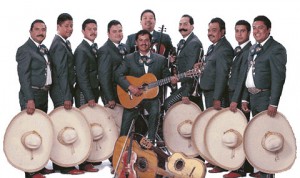Music from Mexico

Mexican Music
About:Music from Mexico is very diverse and features a wide range of different musical styles. It has been influenced by a variety of cultures, most notably indigenous Mexican and European, since the Late Middle Ages. Many traditional Mexican songs are well-known worldwide, although their origin in Mexico is not clear to the non-Mexican listener; Bésame Mucho (Kiss Me a Lot), La Bamba (The Bamba), Solamente una vez (English version “You Belong to My Heart”), La Bikina (The Bikina), Cielito Lindo (Beautiful Sweetheart), Somos Novios (We Are Lovers; English version “It’s Impossible”), El Rey (The King), María Bonita (Pretty María), México Lindo y Querido (Beautiful, Beloved Mexico).1
Similarities to other music styles:Mariachi is only one genre of Mexican son. Mexican son also includes various miscellaneous styles. The guitar is universally present in nearly all Mexican son sub-genres. Other instruments may include trumpets, violins, and accordions.
Mexican son has been rural for most of its history, and requires audience participation for zapateado, or foot-stamping done in a counter-rhythm. Most bands use string instruments and improvised lyrics.
In the 1940s, Mexican music began its rise to international fame, just as Cuban music was topping charts across the globe. Since then, Mexico has absorbed influences from across Latin America, most especially include Colombian cumbia, which is now as much or more known as a Mexican trend than a Colombian one.
Mexican pop music derives from a mixture of Spanish, African and Aztec or other indigenous sources. Related to Cuban son montuno and Venezuelan joropo, Mexican son arose in the 18th century. It is similar to, but historically and characteristically distinct from, Cuban son montuno, despite the similarity in nomenclature. Nine or ten styles of Mexican son have been popular, including mariachi.2
Influences: Mexico has a musical history that is full of cultural contrasts, with many different musical styles and influences. Dating back more than a thousand years before any contact was made with Europeans in the 16th century, the area was dominated by the Aztec culture, a culture that maintained an important and complex musical tradition.
After Cortes’ invasion and conquest, Mexico became a Spanish colony and remained under Spanish dominion for the next two hundred years, incorporating their Pre-Columbian roots together with the lasting influence that came with the Spanish. Both folk and classical music have drawn from these, and regional styles reflect these traditions. The Spanish regime also imported African slaves, adding a third dimension to the areas music.3
DISCOVER MORE
Mexican Popular Music – Tejano, Norteno, Banda
When talking about Mexican popular music, there are so many terms and styles bandied about that it’s easy to become confused. Even the names used to refer to the people that love this vibrant brand of music is confusing and a good place to start. Mexicano refers to a Mexican citizen, chicano to a Mexican-American and Tejano to a Texas-Mexican. The musical genres are a bit more complicated.
Corrido:
Around the time of the Mexican-American war (1840s), the popular musical form was the corrido. Corridos are long ballads that narrate the political and popular issues of the time as well as celebrate great deeds and laud heroic feats, much like a modern epic story. In fact, almost the entire war with America was preserved in the texts of the popular corridos of the time.
As the music evolved into different styles over time, the themes of the corrido did as well. Themes changed to reflect the Mexican experience north of the border especially the lives of migrant workers, the immigrant experience and stories of those involved in the drug trade. These last corridos, called narcocorridos, gained in popularity and have been the topic of great controversy.
Norteno:
Norteno literally means “northern” and is one of the popular forms of music in both urban and rural areas of northern Mexico. Originating in the early 20th century around the Texas-Mexico border, norteno bands originally played corridos and rancheras.
Influence of the Polka:
The polka was another major influence on the music played by norteno bands. Bohemian immigrants that had emmigrated to Texas brought the accordion and polka beat with them and the mariachi and ranchera styles fused with the polka to become the unique norteno genre. If you would like to listen to some great norteno music, try Historias Que Contar by Los Tigres del Norte, one of the best and most durable of norteno bands.
Tejano:
While there is a lot of similarity between norteno and tejano music, both of which originated and evolved along the Mexico-Texas border, tejano music is properly the music that evolved among the Mexican population in South and Central Texas. As a rule, tejano music has a more modern sound, adding musical influences from cumbia, rock and blues. In more recent times, the addition of disco and hip-hop elements has given tejano music a more modern and funky sound.
Selena:
It’s difficult to talk about tejano music without mentioning the genre’s most well-known tejano singer: Selena Quintanilla-Perez. Growing up in Texas, a fan of pop music, Selena and her brother Abraham started playing at local restaurants and festivals. Working modern techno-pop accents into the traditional cumbia style of music, Selena recorded three albums, the third of which went platinum.
Selena was the winner of the 1987 Tejano Music Awards as Best Female Vocalist and Best Singer of the year. She was 24 years old, and working on a breakthrough album Dreaming of You when she was gunned down by the president of her fan club in 1995.
Banda:
While both norteno and tejano music are, at heart, accordion based bands, banda bands are big-band, brass ensembles with heavy emphasis on the percussion. Originating in the northern Mexican state of Sinaloa, banda music (like norteno and tejano)is not one type of music, but incorporates many of the popular Mexican genres like cumbia, corrido and bolero.
Banda bands are large, usually consisting of somewhere between 10 – 20 member, with the notable sound of the tambora (a type of sousaphone) serving as the bass note and rhythmic undertone.4
VIDEOS
Music from Mexico
Source:
1.Music of Mexico, Wikipedia. http://en.wikipedia.org/wiki/Music_of_Mexico
2.Traditional genres of Mexican Music, Wikipedia: http://en.wikipedia.org/wiki/Traditional_genres_of_Mexican_music
3. Mexican Music, About.com: http://latinmusic.about.com/od/countrie1/p/PROBASICS17.htm









